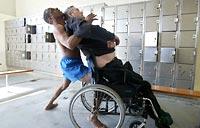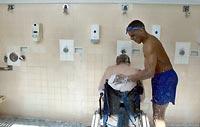Friendship keeps them afloat

Sometimes, if you look down to the deep end of Evans Pool in the Green Lake Community Center, you will see a man swimming. He is not the fastest man in the pool; he does not leave anyone in his Speedo'ed wake, nor does he lift his head at the end of the lane, like an otter, to take one last breath before executing a perfect flip turn.
But he is not the slowest swimmer in the pool, either; he passes many people as he swims, people who have come to the pool to socialize or to cool off but not really to work out. Phil Wood is just a man, swimming, moving under his own steam from one end of the pool to the other, free from the laws of gravity and free, for a few hours each week, to move himself wherever he wants to go.
This is a story about surfaces, and about the importance of looking beneath them.
For if you look beneath the surface of this pool, you will see another man.
Alvin Harkey, in his chlorine-blue swim trunks, holds Phil's toe, ever so gently steering him and guiding him the length of the pool. It is the barest flicker of a touch, a touch at once of great tenderness and great power, the submarine equivalent of Michelangelo's "spark of life" on the ceiling of the Sistine Chapel.
Below the surface, Al's willingness to plunge has brought Phil to heights that would have seemed otherwise unattainable.
Phil and Al have been swimming together at Evans Pool two to three times a week since 1989, when Phil's multiple sclerosis stopped him from swimming by himself. In those 16 years, the only times they have missed have been days where Phil had a fever that prevented him from swimming or when the pool was closed for maintenance.
"My father used to bring me to the pool," says Wood, 64. "He would help me in the dressing room and then I swam on my own, until I could no longer keep my face out of the water." Soon Wood's father could not do the lifting involved and Wood was going to have to give up swimming.
Enter Alvin Harkey. Harkey was just another swimmer who observed Wood and his father in the locker room and realized how he could make a difference.
"I worked the swing shift at the Vitamilk Dairy near Green Lake," says Harkey, 52. "I'd work from 5 p.m. to 4 a.m. I used to go swimming in the afternoon to unwind before work. I saw Phil's father struggling and knew I could help."
Harkey began by helping Wood's father with his son's clothing. Soon the two were working on stretching exercises in the locker room. They began swimming together when Harkey noticed that Wood needed help in the pool as well.
"Phil could pull with only one arm in the water," Harkey says. "Soon he would be swimming in a little circle and his father would give him the lifeguard pole and steer him away from the edge and he'd begin swimming in another little circle."
Wood was also having an increasingly difficult time getting into the water. "The lifeguards would pick him up and throw him in the deep end, before they installed a lift chair at the pool," Harkey says. "He'd hold his breath until I got there and I'd fish him out and get him to the surface."
"It was an easy way to get used to the water," Wood says.
The routine
The two men have perfected what they call "the routine." Twice a week they meet at Evans Pool at noon to embark on an exercise regime that Harkey calls "flexology." Sometimes Harkey drives Wood, and sometimes Wood is brought to the pool by his mother, Gladys, and his sister, Cathy Shives."I am sure Al is the reason Phil has stayed as healthy as he is," Shives says. "Phil looks forward to this. Al is family. Phil says Al is like his brother or his father."
"Al knows just how to do it," says Gladys Wood. "He cheers Phil on."
"Flexology" consists of a 40-minute series of stretching and strengthening exercises that Harkey and Wood have developed over the years. It is, Harkey says, "where the physical and the mental connect."
"First we do the 'Iron Cross,' " Harkey says. This is an intense stretch in which Harkey hooks Wood's arms in the trough at the edge of the pool and then pushes against his back. They follow this with the "Herky-Jerky Blah Blah," in which Harkey holds Wood's arm up and pulls with his feet against Wood's ankles. The routine straightens Wood's spine and simulates standing. Both men grunt and grimace as though they are being tortured.
Wood's explanation is quite simple. "Al likes pain," he explains.
After the stretching, the two swim several laps, Wood moving himself with his arms and Harkey holding Wood's toe underwater, steering and keeping him from rolling onto his side. They have occasional near-misses, tidal waves caused by teenagers doing belly flops and close calls with other swimmers coming straight at them.
"I am his eyes and his rudder," Harkey says. "I steer him, but he does the work. He gets no free ride from me."
"When I first get in the pool I can't move at all," Wood says. "Al stretches the muscles I can't move on my own. Al moves them for me. After he stretches them out I can move my arm on my own. Without Al, I would lose my mobility.
"My arms are pretty much all I have."
On days that Wood swims, he is more limber afterward and has fewer muscle spasms.
The exercise program is strenuous for both men, and both work to the edge of physical exhaustion. "People always ask the guards, 'Are you hurting that man?' " Wood says. " But Al has a feel for me after all these years."
The A Team
So what drives Alvin Harkey to spend two days a week for 16 years swimming with a man who was once a total stranger?"I have had my struggles," he says. "Along the way I've needed help. I saw where I could make a difference with Phil. I'm not going to be a brain surgeon. My attributes are physical. I knew I could give him the physical and mental will to keep going.
"We call ourselves 'The A Team.' Phil has no peers and neither do I."
Harkey's dream is to offer "flexology" workshops to others who would like to learn how to help people with disabilities.
"Phil is a world-class athlete, going one-on-one with himself," Harkey says. "There's not anyone anywhere who could do what he does, no matter what age they are, no matter if they're disabled or not."
Harkey adds that he couldn't have lasted this long without the support of "Phil's amazing family, the staff at Green Lake, and my boss, Trevor Cobb, who has given me the flexibility to be able to continue this work."
What do the men think about when they are in the water, working to the last ounce of their strength against a disease that has no known cure? "All I'm thinking," Wood says with a laugh, "is how good this is going to feel after I get out."
Harkey has a different thought.
"I keep telling him that next week, next month, next year, when someone comes up with a cure for MS, he has to be ready. Sometimes I get that Walter Mitty thought," he says, referring to the James Thurber character who imagined other lives for himself, "that one day Phil will get up and reclaim his life and I would know that I was a part of that."
And so the two keep moving, twice a week, flowing through challenges that others can only imagine, keeping their heads above water even on the days when it would be easy to give up. On the rare day that Wood doesn't feel up to working out, Harkey pushes him even harder.
"I tell him, 'The more you yawn, the harder you'll work,' " he says. "Every time Phil steps into the water, it's a fight for his life."
And sometimes it is Harkey who finds himself faltering, and Wood is there to buoy him as well.
"When I am down, Phil gives me his spirit of always being there and always being positive. His spirit is what drives me," he says. "On most days, it's Phil who keeps me afloat."
Dana Standish is a freelance writer based in Seattle: danastandish@yahoo.com

